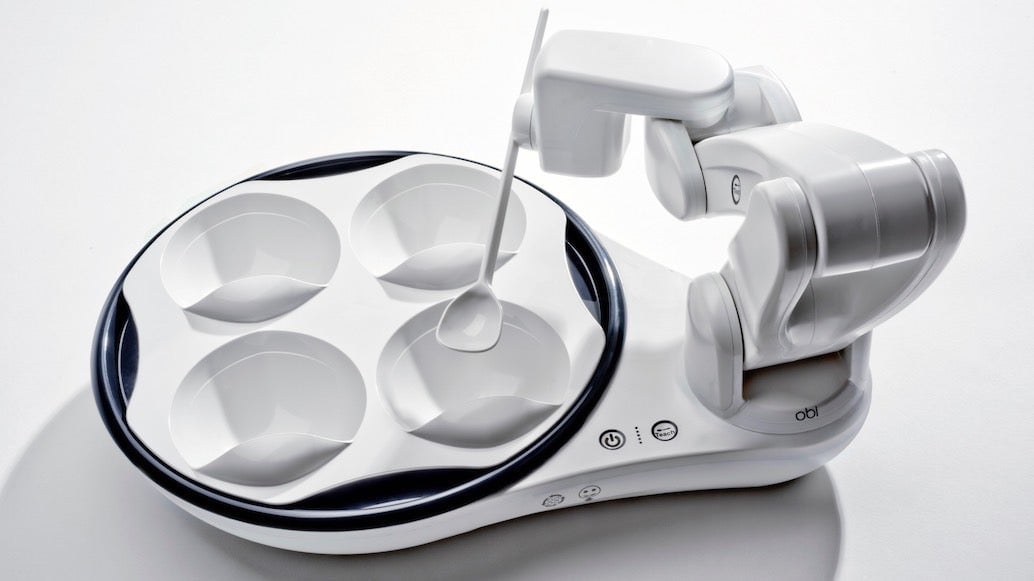A robotic dinner plate with a human-like arm is revolutionizing the lives of the differently abled
Golf, offshore powerboat racing, sky diving: David Hare had led an active lifestyle. Then, in February 2011, he was diagnosed with ALS, a neurological disease that leads to rapid progressive degeneration of nerve cells, the loss of the ability to control muscle movement, and eventually death. The 56-year-old Michigan resident, who was told by doctors that he had less than five years to live, found a new lease of life last year with Obi, a robot that helps the differently abled feed themselves.


Golf, offshore powerboat racing, sky diving: David Hare had led an active lifestyle. Then, in February 2011, he was diagnosed with ALS, a neurological disease that leads to rapid progressive degeneration of nerve cells, the loss of the ability to control muscle movement, and eventually death. The 56-year-old Michigan resident, who was told by doctors that he had less than five years to live, found a new lease of life last year with Obi, a robot that helps the differently abled feed themselves.
Obi includes a placemat with a dinner-plate-sized dish with four compartments on top, which mount onto a white platform. Attached to one side of the sleek, white platform is a robotic arm fitted with a spoon. Once placed on a table in front of the recipient, a caregiver can grasp the arm and teach Obi the delivery location. After that, the robot is able to replicate the process.
“Ten years ago, through a variety of family and volunteer experiences, I realized there were millions of people that were extremely unhappy and frustrated with being fed or force fed by others. Eating is a basic human need, a fundamental freedom and an intimate personal experience,”Jon Dekar, who developed the first Obi prototype in 2006 while studying to become a mechanical engineer at University of Dayton, told Quartz. “People also feel guilty asking another friend or family member for constant help.”
Along with his retired father, Dekar founded the company DESῙN and honed the robot’s design to function as a seamless eating aid for the differently abled. A decade after the first prototype, the creator of the robotic dining companion unveiled the robot:
“I tell people ALS stands for Always Losing Something. Obi has given me something back,” Hare said in the video. Speaking about the device, which retails for a $4,500 on its website, Hare added that you can’t put a price tag on the sense of independence—however small—that it can provide. Every year, more than 5,600 people are diagnosed with ALS, according to the ALS Association. Currently, 30,000 Americans are affected by the disease that typically only gives people two to five years to live since the time of diagnosis.
The autonomy Obi can provide is empowering for the differently abled. To operate the device, users can attach two accessibility switches to it—one allows them to toggle between the different food compartments and another triggers the arm to feed. Its rechargeable battery lasts two to four hours. The robotic arm has the agility to scrape the sides of bowls to pick up differently textured items, from bigger grapes to finer rice grains. If Obi’s arm is obstructed by any object before it reaches its destination, the device backs away and waits for the feeding command again.
Co-robots like Obi aren’t an entirely new phenomenon: The US government has funded research for a handheld device to help the visually impaired identify and grasp objects and a “smart-walker” for seniors and people with mobility impairments. A personal robot that can be controlled by eye and finger movement can shave, scratch and even fetch towels for the differently abled. But when it comes to feeding, there hasn’t been much progress.
“I could sit across and look at my wife now and feed myself and let her enjoy her meal,” said Hare. “It was just wonderful that I could find something that would lessen the load on her. It changed the direction of my life.”